About Creative Commons
Sorry, no listings were found.
Managing Separation Anxiety after Covid-19 Lockdown
How to help Dogs and Cats manage Separation Anxiety when their humans return to work

Lori M. Teller, Texas A&M University
When one of my co-workers found out about a tiny, orphaned kitten that needed a home a few months ago, he didn’t hesitate to adopt it. He says his new companion helped make the months of COVID-19 isolation at home much less stressful.
He is not alone. Animal shelters and breeders across the country have reported record numbers of dog and cat adoptions in recent months.
But after my co-worker returned to work, he says his adorable kitten started urinating on the kitchen counter while he was away.
Another friend is worried about how her dog will react when she returns to the office. Her big, goofy Labrador retriever follows her everywhere, even to the bathroom. When she leaves to run a quick errand, the dog sits by the back door and whines, awaiting her return.
What should these pet owners do?
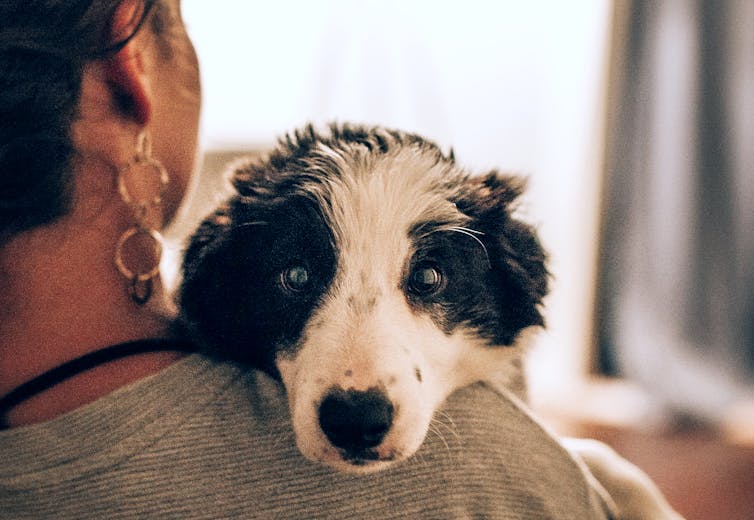
The problem with sudden changes in routine
A change in routine, such as suddenly being alone for many hours every day, is a major cause of separation anxiety for both dogs and cats.
Separation anxiety is more than a little whimpering when you head out the door. It’s major, unwanted behavior that happens every time you leave or are away.
For dogs and cats, this can mean excessive pacing, barking or howling, whimpering or self-grooming as you get ready to leave. In some cases it can mean urinating or defecating around the house, often in places where scents linger, such as on bedding or rugs, or destroying household items in your absence. Extreme clinginess or neediness is another symptom.

Separation anxiety won’t go away on its own, and it can be difficult to get rid of entirely. But there are ways to manage it. As a clinical veterinarian and professor, I am often asked to help people find ways to ease their pets’ anxiety.
What not to do
First, it’s important to understand that it’s not about you – it’s about your pet. Your dog or cat is not trying to teach you a lesson or get revenge. Animals don’t act out of spite.
Instead, it’s a signal of extreme distress and frustration that should be approached like any other medical ailment. Your pet doesn’t want to experience separation anxiety any more than you want to experience its consequences.
For this reason, punishment is never the answer. For one thing, your pet won’t connect the punishment with something that happened hours – or even a few minutes – earlier. And punishment may only exacerbate your pet’s anxiety and stress.

Similarly, going to the opposite extreme by praising or giving affection when your pet is suffering anxiety also will make the problem worse.
The goal is to create a balanced relationship so your pet tolerates being alone. First, get your pet checked out by a veterinarian to rule out physical conditions, such as a urinary tract infection if your pet urinates in inappropriate places.
Next, make sure your pet gets plenty of exercise and mental stimulation. For dogs, this may mean a long run or brisk walk every day. Getting exercise shortly before you leave the house may put your dog in a more relaxed state while you’re gone. It’s harder to feel stressed when the endorphin levels are elevated. For cats, this could mean a change of environment by being outdoors in a safe, enclosed area such as a “catio.”

Treating separation anxiety with behavior change
Here, we’re talking about your behavior. The goal is to make your absence seem like no big deal. Making a fuss over your pet when you leave or arrive home only makes matters worse. If you treat it like it’s routine, your pet will learn to do the same.
Try to figure out when your pet starts to show signs of anxiety and turn that into a low-key activity. If it’s when you pick up your handbag, for example, practice picking it up and putting it back down several times over a few hours. Similarly, get dressed or put on your shoes earlier than usual but stay home instead of leaving right away. Try starting your car’s engine and then turning it off and walking back inside.
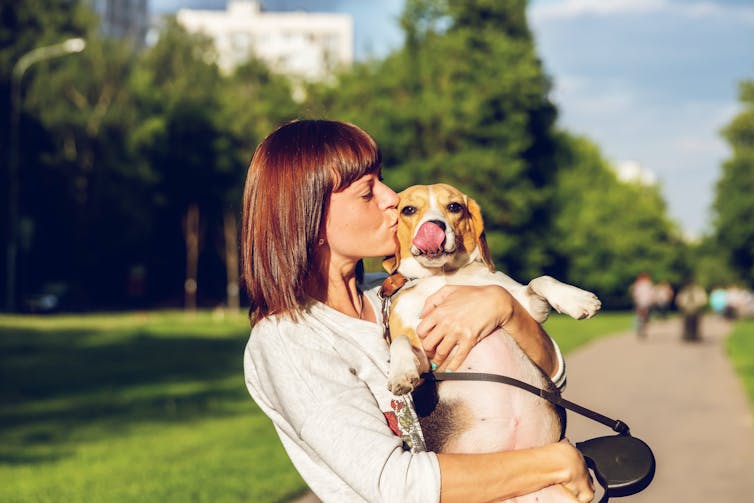
Next, practice short absences. When you’re at home, make it a point to spend some time in another room. In addition, leave the house long enough to run an errand or two, then gradually increase the time that you’re away so that being gone for a full day becomes part of the family routine.
Changing the environment
Boredom makes separation anxiety worse. Providing an activity for your pet while you’re gone, such as a puzzle toy stuffed with treats, or simply hiding treats around the house will make your absence less stressful. Other options for dogs and cats include collars and plug-in devices that release calming pheromones.
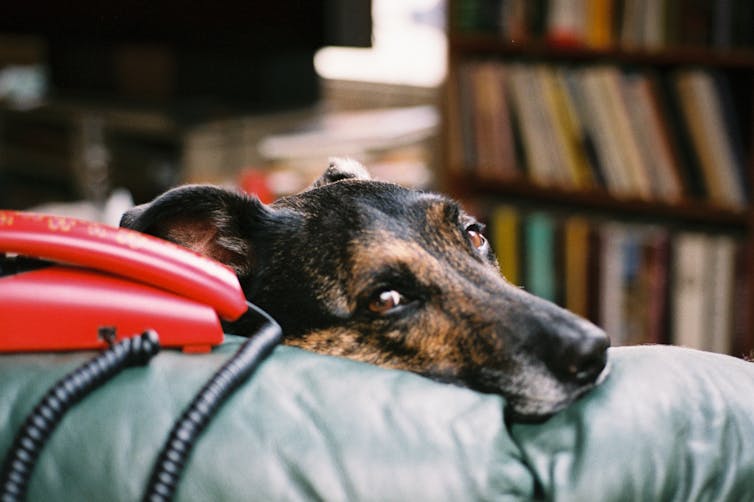
To maintain your bond while you’re gone, place a piece of clothing that you have worn recently in a prominent place, such as on your bed or couch, to comfort your pet. Similarly, you can leave the TV or radio on – there are even special programs just for pets – or set up a camera so you can observe and interact with your pet remotely. Some of these come equipped with a laser pointer or treats you can dispense.
Using supplements or medication
In some severe cases, when the animal harms itself or causes property damage, medication or supplements might be necessary. These alter the brain’s neurotransmitters to create a sense of calm.
[Deep knowledge, daily. Sign up for The Conversation’s newsletter.]
While some are readily available without a prescription, it’s a good idea to get advice from your veterinarian to determine which are safest and most effective for your pet’s situation. Medication can help reduce the anxiety, making it easier for the pet to learn new coping skills. A behavior modification plan accompanying the use of medication can help manage this problem.
Separation anxiety is difficult for both you and your pet. But a few simple changes can make a huge difference as life returns to some semblance of normal.
Lori M. Teller, Clinical Associate Professor, Veterinary Telehealth, Texas A&M University
This article is republished from The Conversation under a Creative Commons license. Read the original article.
1899 total views, 0 today
Reasons to #Adopt a pandemic pooch – smarts!
Your Dog’s nose knows no bounds – and neither does its love for you
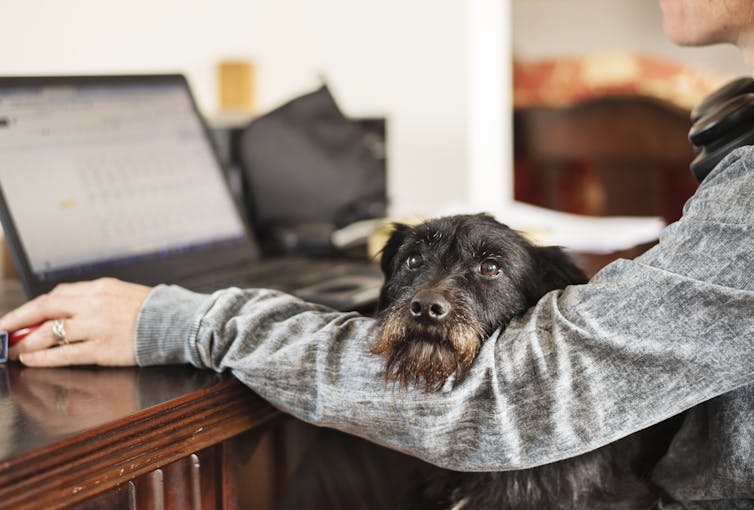
Ellen Furlong, Illinois Wesleyan University
I have discovered one positive amid the pandemic: I love working with two dogs at my feet.
As someone who studies dog cognition, I often wonder: What is Charlie learning when he stops to sniff the crisp fall air? What is Cleo thinking when she stares at me while I write? Are my dogs happy?
I’m not alone in finding myself suddenly spending more time with my pups and contemplating what’s on their minds. More people in the U.S. are working from home now than are working in the workplace, and many now share home offices with their canine companions. What’s more, many are finding their lives enriched with the addition of a new pet, as people started adopting dogs at massive rates during the pandemic.
This uptick in dog time means I have been fielding questions from new and experienced dog owners alike about their companions’ mentalities. Many questions center on the same themes I ponder: What is my dog thinking? Am I doing everything I can to ensure my pup is content?
Fortunately, research on dog cognition can help unravel what is on their minds and provide insight into what they need for psychologically fulfilling and happy lives.
Smelling superstars
Dogs are both familiar and yet fascinatingly alien. To appreciate their “otherness” all you need to do is consider their sensory world.
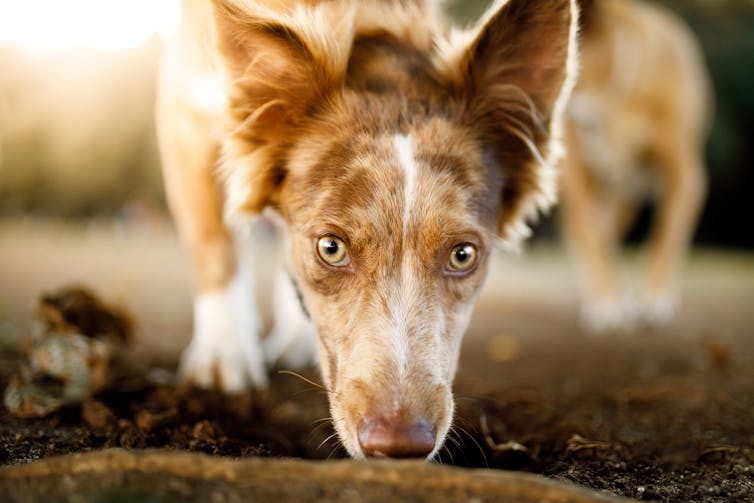
My dogs and I have very different experiences when we walk a trail. I marvel at the beautiful autumn day, but my dogs have their heads to the ground, seemingly ignoring the wonders around them.
However, they are appreciating something I can’t perceive: the scent of the fox who scampered through last night, the lingering odor of the dogs who’ve walked this way and the footsteps of my neighbor, who last wore her hiking shoes in woods my dogs have never visited.
You’ve probably heard about dogs who sniff out cancer, weapons or even coronavirus. These dogs are not special in their nose power: Your dog could do the same thing. In fact, the first dog to sniff out cancer sniffed a mole on his owner’s leg so frequently that she went to the dermatologist, where she was diagnosed with melanoma.
A dog’s sense of smell is estimated to be 10,000 to 100,000 times better than that of a human. This is due, in large part, to staggering differences in odor processing in humans and dogs.
While we have about 6 million olfactory receptors, dogs have a staggering 300 million. Their epithelium, or nasal tissue, is about 30 times larger than ours. And while people have between 12 million and 40 million olfactory neurons – specialized cells involved in transmitting odor information to the brain – dogs, depending on the breed, can have 220 million to 2 billion!
How can you even conceptualize this breathtaking difference in abilities? This disparity is like detecting one teaspoon of sugar in enough water to fill two Olympic sized swimming pools.
Now that your mind has been blown about your dog’s incredible sense of smell, you can use this information to make your dog happier by taking it on the occasional “sniffy walk” – letting it lead the way and take as much time to smell as it would like. Such walks can make dogs happier by allowing them to gain lots of information about the world around them.
The love is mutual
While there are parts of a dog’s mind that are alien, there are also parts that feel very familiar. Chances are, your dog occupies a special place in your heart. Recent research suggests your dog feels the same way about you. Your dog adores you.
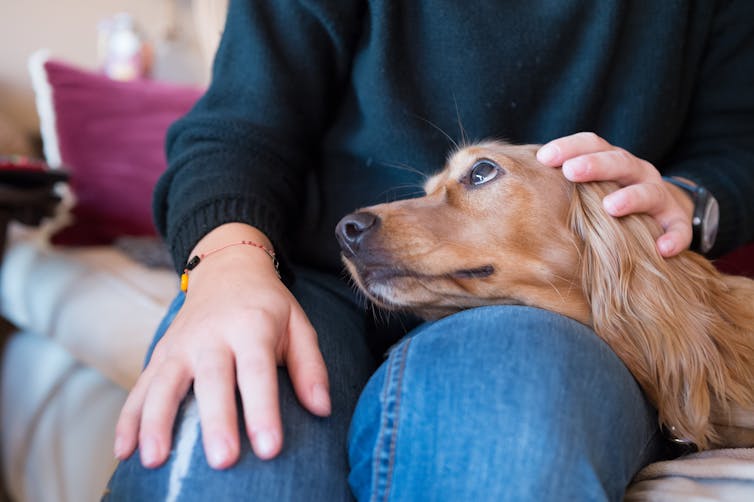
Dogs attach to their owners in much the same way human infants attach to their parents. Like babies, dogs show distress when left with a stranger and rush to reunite upon their person’s return.
A recent study found that dogs that have been deprived of food and owners choose to greet their owners before eating. Further, their brain’s reward centers “light up” upon smelling their owners. And, when your eyes meet your dog’s, both your brains release oxytocin, also know as the “cuddle hormone.”
[Deep knowledge, daily. Sign up for The Conversation’s newsletter.]
All of this research shows that you can make your dog happier with just one ingredient: you. Make more eye contact to release that cuddle hormone. Touch it more – dogs like pats better than treats! Go ahead and “baby talk” to your dog – it draws the dog’s attention to you more and may strengthen your bond.
Understanding your dog’s mind can not only sate your curiosity about your companion, but can also help you ensure your pup lives a good, happy life. The more you know about your furry friends the more you can do to meet their needs.
And now I am off to gaze into Cleo’s bright blue eyes, give Charlie a belly rub, and then let them take me on a “sniffy” walk.
Ellen Furlong, Associate Professor of Psychology, Illinois Wesleyan University
This article is republished from The Conversation under a Creative Commons license. Read the original article.
1200 total views, 0 today
Covid-19 / Coronavirus Detector Dogs across the world
These dogs are trained to sniff out the coronavirus. Most have a 100% success rate

Susan Hazel and Anne-Lise Chaber
What does a pandemic smell like? If dogs could talk, they might be able to tell us.
We’re part of an international research team, led by Dominique Grandjean at France’s National Veterinary School of Alfort, that has been training detector dogs to sniff out traces of the novel coronavirus (SARS-CoV-2) since March.
These detector dogs are trained using sweat samples from people infected with COVID-19. When introduced to a line of sweat samples, most dogs can detect a positive one from a line of negative ones with 100% accuracy.
Across the globe, coronavirus detector dogs are being trained in the United Arab Emirates (UAE), Chile, Argentina, Brazil and Belgium.
In the UAE, detector dogs – stationed at various airports – have already started helping efforts to control COVID-19’s spread. This is something we hope will soon be available in Australia too.
A keen nose
Our international colleagues found detector dogs were able to detect SARS-CoV-2 in infected people when they were still asymptomatic, before later testing positive.
When it comes to SARS-CoV-2 detection, we don’t know for sure what the dogs are smelling.

The volatile organic compounds (VOCs) given off in the sweat samples are a complex mix. So it’s likely the dogs are detecting a particular profile rather than individual compounds.
Sweat is used for tests as it’s not considered infectious for COVID-19. This means it presents less risk when handling samples.
Read more: Explainer: what’s the new coronavirus saliva test, and how does it work?
COVID-19 sniffing dogs in Australia
Here in Australia, we’re currently working with professional trainers of detector dogs in South Australia, Victoria and New South Wales. The most common breed used for this work so far has been the German shepherd, with various other breeds also involved.
We are also negotiating with health authorities to collect sweat samples from people who have tested positive to the virus, and from those who are negative. We hope to start collecting these within the next few months.
We will need to collect thousands of negative samples to make sure the dogs aren’t detecting other viral infection, such as the common cold or influenza. In other countries, they’ve passed this test with flying colours.
Once operational, detector dogs in Australia could be hugely valuable in many scenarios, such as screening people at airports and state borders, or monitoring staff working in aged care facilities and hospitals daily (so they don’t need repeat testing).
To properly train a dog to detect SARS-CoV-2, it takes:
- 6-8 weeks for a dog that is already trained to detect other scents, or
- 3-6 months for a dog that has never been trained.
Could the dogs spread the virus further?
Dogs in experimental studies have not been shown to be able to replicate the virus (within their body). Simply, they themselves are not a source of infection.
Currently, there are two case reports in the world of dogs being potentially contaminated with the COVID-19 virus by their owners. Those dogs didn’t become sick.
Read more: Hong Kong dog causes panic – but here’s why you needn’t worry about pets spreading COVID-19
To further reduce any potential risk of transmission to both people and dogs, the apparatus used to train the dogs doesn’t allow any direct contact between the dog’s nose and the sweat sample.
The dog’s nose goes into a stainless steel cone, with the sweat sample in a receptacle behind. This allows free access to the volatile olfactory compounds but no physical contact.
Furthermore, all the dogs trained to detect COVID-19 are regularly checked by nasal swab tests, rectal swab tests and blood tests to identify antibodies. So far, none of the detector dogs has been found to be infected.
Hurdles to jump
Now and in the future, it will be important for us to identify any instances where detector dogs may present false positives (signalling a sample is positive when it’s negative) or false negatives (signalling the sample is negative when it’s positive).
We’re also hoping our work can reveal exactly which volatile olfactory compound(s) is/are specific to COVID-19 infection.
This knowledge might help us understand the disease process resulting from COVID-19 infection – and in detecting other diseases using detector dogs.
This pandemic has been a huge challenge for everyone. Being able to find asymptomatic people infected with the coronavirus would be a game-changer – and that’s what we need right now.
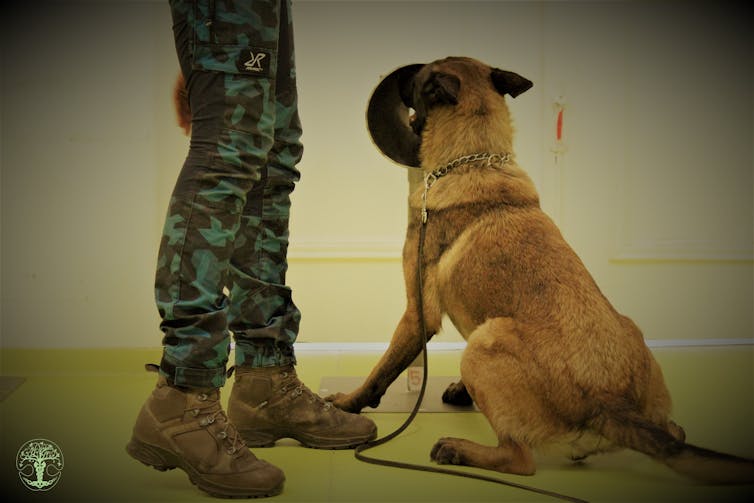
A friend to us (and science)
Perhaps we shouldn’t be surprised about dogs’ ability to detect COVID-19, as we already know their noses are amazing.
Dogs can help detect hypoglycaemia in diabetics, warn people who are about to have an epileptic seizure and have been used to sniff out some cancers.
Their great potential in dealing with the current pandemic is just one of myriad examples of how dogs enrich our lives.
We acknowledge Professor Riad Sarkis from the Saint Joseph University (Beirut) and Clothilde Lecoq-Julien from the Alfort Veterinary School (France) for first conceiving the idea underpinning this work back in March.
Susan Hazel, Senior Lecturer, School of Animal and Veterinary Science and Anne-Lise Chaber, One Health Lecturer, School of Animal and Veterinary Science
This article is republished from The Conversation under a Creative Commons license. Read the original article.
1024 total views, 3 today
Pandemic Pets – Covid-19 lockdowns cause a worldwide Pet Adoption boom
How the coronavirus pet adoption boom is reducing stress for humans
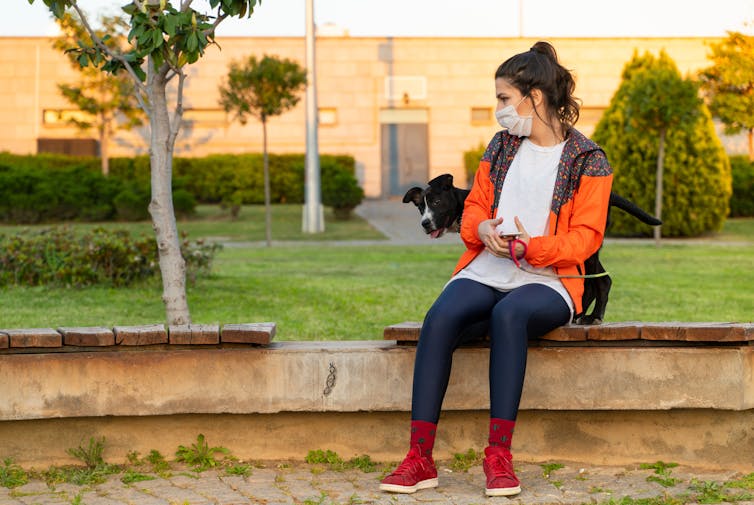
L.F. Carver, Queen’s University, Ontario
As has been discussed in so many articles, sharing our lives with pets is good for our health. Not only do they make us healthier in normal times, in stressful times the benefit of a pandemic puppy (or cat), or other non-human companion, goes even further.
Read more: When pets are family, the benefits extend into society
During a pandemic, people can be stressed and fearful for their lives and the lives of those they love. Research has shown that where there is a bond between human and animal, the presence of a non-human companion — especially a dog — decreases psychological arousal and stress, and creates physiological changes that make us feel better.
Pandemic pets
Early in the COVID-19 pandemic there was pet abandonment in large numbers in Wuhan, China. Fearful that the same would happen locally, many animal rescue organizations set out to empty their shelters. Worldwide there was an unprecedented upsurge in adoptions and fostering.
Although many people did this for the animals, they, perhaps unwittingly, set themselves up for better mental health during the pandemic. Aside from the stress-mitigating impacts of pets mentioned above, having a pet may be a powerful influencer in maintaining health-protective behaviours, such as eating well or going out for a walk.
Dogs and cats can increase physical rehabilitation goals through behaviour such as “bending, reaching, ambulating and using both arms in a functional manner to provide food, water, and grooming.” These basic activities involved in animal care actually provide exercise, which is very important for people who spend the day in a stationary position.
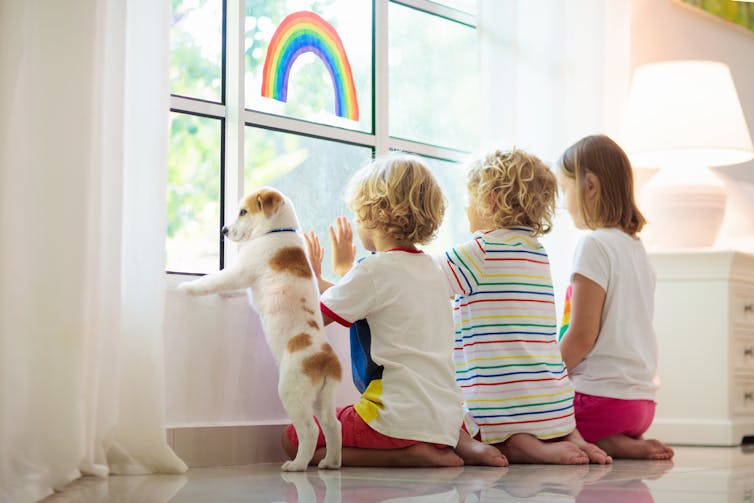
Human-animal relationships
When the COVID-19 pandemic began, I had just started a research study asking people about their relationships with their non-human companions. The preliminary results of this online survey include people between their late 30s and early 90s. They live in Canada, the United States, England, Ireland, Wales and Scotland and come from all walks of life. One-third have completed high school or less, 30 per cent completed college and/or an apprenticeship and the rest completed some kind of university degree. At the time of the survey, almost all of them were spending their time at home, some were alone, others with family and for others pets were their only companions.
When asked, in an open-ended question, what it has been like having animal companions with them during the pandemic, their answers included words like “comforting,” “good/great,” “helpful.” Several people said that they work full-time, so they were enjoying the time with their animal and getting to see what their pet does all day. Several people indicated that they would be lost without their pet.
One participant said, “I don’t know what I would do without the company of my dog, she has kept me going.” Another said, “It is the only thing that is keeping me sane.” And others said the presence of a pet was salvation (a life saver) and brought joy. There were also those who said they talk with their pet and that it helped stave off loneliness.
Artificial pets?
Another question I ask in my research is whether robot pets can be used to replace live animals, so it was interesting to see that robot pets were being provided to older adults during the COVID-19 pandemic.
Read more: Robopets: Using technology to monitor older adults raises privacy concerns
In my survey during the COVID-19 pandemic, respondents were asked whether, given the choice, they would choose a robot pet or a live animal. Out of 102 people who answered this question, not one of them said they would choose a robot pet — even those who currently did not have a pet did not want a robot pet. The vast majority said they would choose a live pet, and a few said that they would rather have no pet at all.
When asked why, they said things like, “It is not about the companionship alone. It is about the emotional connection. To get that from a robotic creation is not love. We need the love that comes with these pets.” It was very clear that the robots were “not the same as a living breathing animal.” That a robot could not take the place of a pet because pets are “unique and make me smile and love them.” https://www.youtube.com/embed/tLjtOMBWvTo?wmode=transparent&start=0 A Washington Post video comparing Sony’s robot dog Aibo to a live puppy.
The results of this survey are similar to those found during non-pandemic research: pets stave off loneliness, and living with pets helps people to be more active, even if it is only the movement associated with basic tasks, such as cleaning the litter box or filling food bowls. Most importantly, we are comforted by these non-human companions. The presence of a dog or a cat in the home may be the only thing between an isolated person and despair.
Given how important dogs, cats and other non-human companions are to our well-being, it is important to remember them when developing programs to support isolated people. When there is not enough money to go around, “it is not unheard of for people to feed their dog before they feed or acquire medications for themselves.”
As the economic reality of sustained unemployment unfolds, it is important for public services to consider not only food security for humans, but also for their non-human companions in order to prevent the possibility of a tsunami of pet abandonment due to an inability to provide care.
L.F. Carver, Assistant Professor & Privacy and Ethics Officer at the Centre for Advanced Computing, Queen’s University, Ontario
This article is republished from The Conversation under a Creative Commons license. Read the original article.
970 total views, 0 today
Covid-19, aka Coronavirus, and Pets – UPDATE April 2020
Can your Pets get Coronavirus, and can you catch it from them?
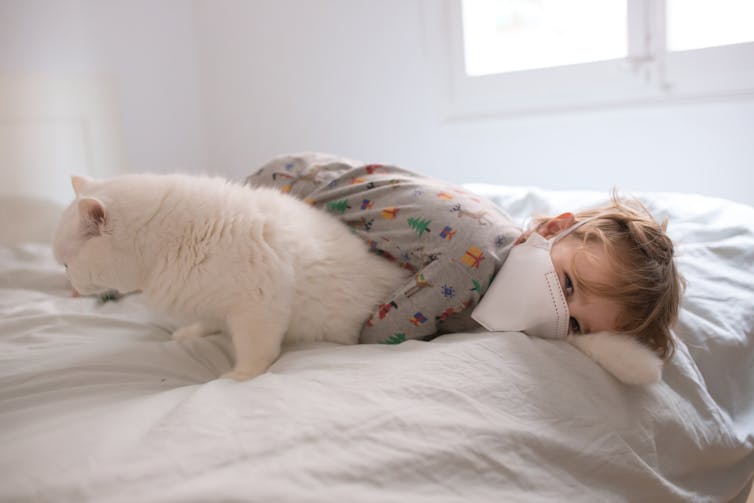
Annette O’Connor, Michigan State University; Jan Sargeant, University of Guelph, and Sarah Totton, University of Guelph
Humans and animals share many diseases. And as dramatically shown by the tigers that tested positive in the Bronx Zoo, the coronavirus is one of them. As three veterinary epidemiologists who study infectious disease, we have been asked a lot questions about if and how the coronavirus SARS-CoV-2 affects pets.
Can my pet get the coronavirus?
When talking about a virus, the words “get” or “catch” are vague. A more precise question is: Can my cat or dog become infected with SARS-CoV-2?
The answer is yes. There is evidence from real-world cases as well as laboratory experiments that both cats and dogs can become infected with coronavirus.
In Hong Kong, health officials have tested 17 dogs and eight cats living with COVID-19 patients for the coronavirus. They found evidence of the virus in two dogs: a Pomeranian and a German shepherd, though neither became sick.
None of the eight cats were infected or had been sick. However, there is a separate report of an infected cat from Hong Kong.
Another case of an infected cat was reported in Belgium. Again, the owner of the cat had COVID-19, but unlike the infected cat in Hong Kong, this one had become sick with respiratory problems as well as diarrhea and vomiting.
The final evidence comes from Wuhan, where researchers tested 102 cats and released a pre-print study of the results. Fifteen of those cats tested positive for the antibodies to the virus – meaning the cats been exposed in the past. As the researchers say in the paper, the coronavirus has “infected cat populations in Wuhan, implying that this risk could also occur at other outbreak regions.” This study tested cats from owners with COVID-19, veterinary hospitals and even some strays. Three of the infected cats were owned by COVID-19-affected patients which explains their exposure; for the other 12 it is unclear how they were infected.

Can my pet spread the virus to another animal?
If cats or dogs can spread the coronavirus, health agencies and the public would need to incorporate these animals into their planning to contain and slow the pandemic. It is very important to know how easily the coronavirus replicates in pets and whether they can transfer it to other animals. A group of researchers in China set out to answer these questions.
To do this, they inoculated – that is, directly exposed – a number of cats and dogs with the coronavirus by deliberately placing large doses of live SARS-CoV-2 into their noses. The scientists then put some of these inoculated animals next to uninfected control animals to see if the exposed animals got sick, could spread the virus to the uninfected animals, or both.
The researchers found that kittens and adolescent cats can become infected when given a large dose of the virus. All five of the kittens who were inoculated became sick and two died, but all of the adolescent cats were able to fight off the infection without becoming seriously ill.
They also found that cats can spread the coronavirus to other cats. After a week, one-third of the uninfected cats that were placed next to the inoculated cats tested positive for the coronavirus.
These results provide evidence that SARS-CoV-2 can replicate in cats and can make them sick. It also shows that cats can transfer the virus through the air to other cats.
The same researchers also looked at dogs and found them to be much more resistant to the virus and unable to transmit it to other animals.
This is important information, but the conditions of the experiment were very unnatural. There are no studies about transmission of the virus between cats and dogs in the real world so it remains unclear whether natural transmission is occurring. While this experiment shows that cats and dogs are not totally immune to the coronavirus, the lack of a pandemic among household pets provides some evidence that they are more resistant than people are.
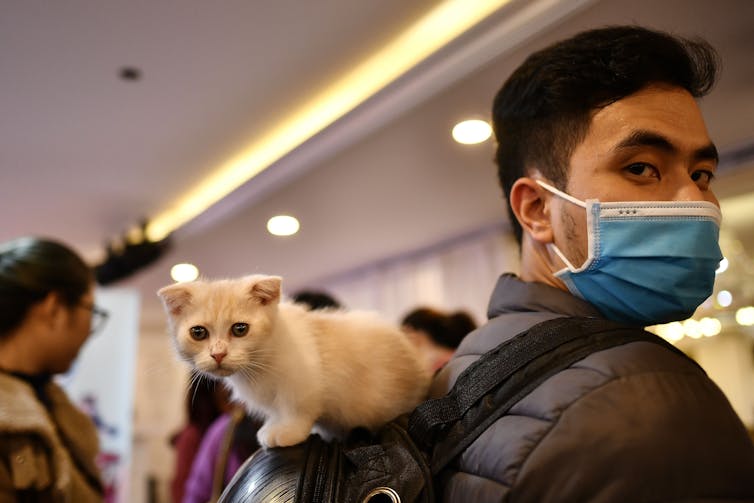
Can I get the coronavirus from my cat?
While we can’t say it would be impossible to catch the coronavirus from a cat or dog, the research suggests this is extremely unlikely. There are currently no reported cases of people catching the coronavirus from animals.
The World Health Organization says that “based on current evidence, human to human transmission remains the main driver” of the COVID-19 pandemic, but that “further evidence is needed to understand if animals and pets can spread the disease.”
The Centers for Disease Control and Prevention says that there is no evidence pets can spread COVID-19 to people.
While your cat can get infected, according to the science, it is extremely unlikely they could pass it to you. In fact, if your cat is infected, the chances are your cat caught the coronavirus from you.
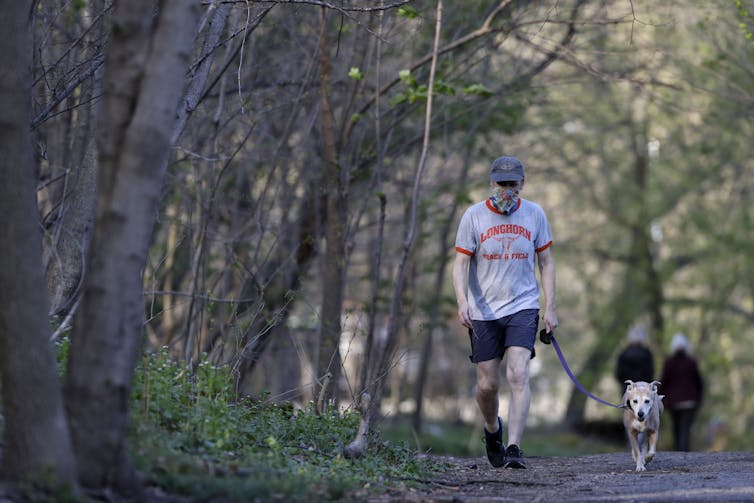
Should I keep my cat inside or change my dog’s behavior?
Although the chances of your pet catching the coronavirus from another animal are low, if you take your dog or cat outside, have your pets follow the same rules as everyone else – keep them away from other people and animals.
If a dog approaches you, there is no need to be scared of getting sick from virus on the dog’s fur. But avoid approaching dogs on leashes – not because of the dog, but because there is usually a human on the other end.
If you become ill with COVID-19, the CDC recommends that you isolate yourself from your pets and have someone else care for them. If that isn’t possible, continue to wash your hands frequently and avoid touching your face.
Also remember: If your pet needs medical care, make sure you inform your veterinarian if you or a household member is ill with COVID-19. That information will allow your veterinarian to take adequate precautions.
The evidence around pets and the coronavirus is changing rapidly and our team is keeping an updated review about how cats, dogs, ferrets, other less common pets and livestock are affected by the new coronavirus. But where the science stands today, there is little to worry about with regards to your cat or dog. In rare cases, they might become infected with the virus, but the chances of them getting sick from the infection or passing it on to you or another animal are extremely low.
[Get facts about coronavirus and the latest research. Sign up for The Conversation’s newsletter.]
Annette O’Connor, Professor of Veterinary Epidemiology, Michigan State University; Jan Sargeant, Professor of Veterinary Epidemiology, University of Guelph, and Sarah Totton, Research Assistant, University of Guelph
This article is republished from The Conversation under a Creative Commons license. Read the original article.
828 total views, 0 today
Managing Pets during Covid-19 Lockdown / Quarantine
Routine and learning games: how to make sure your dog doesn’t get canine cabin fever
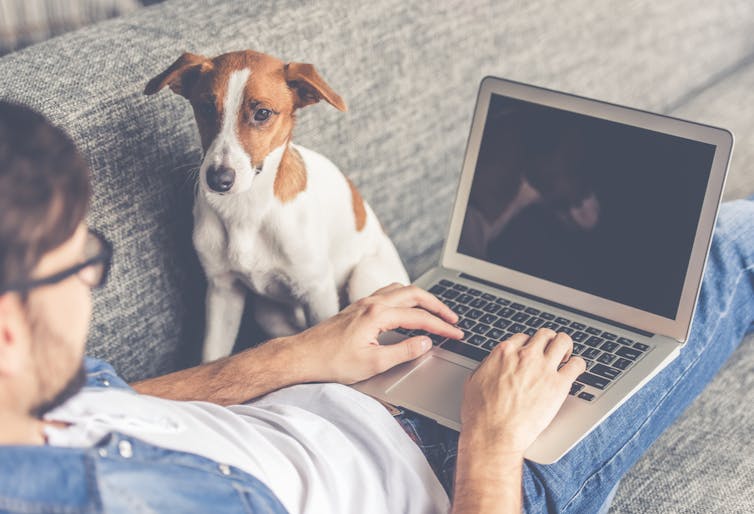
Melissa Starling, University of Sydney; Jacqueline Norris, University of Sydney, and Paul McGreevy, University of Sydney
As coronavirus forces us to isolate, some news outlets are suggesting now is the ideal time to bring a dog into your life. But the current changes have some far-reaching implications for dogs of all ages, and especially for puppies.
Staying home and not socialising your dogs, most notably puppies, risks them becoming afraid of unfamiliar people and other dogs.
This, combined with a being in an urban environment for a long time, relative inactivity, and sub-optimal training activities, could set up a COVID-19 generation of dogs who aren’t equipped for urban and suburban living.
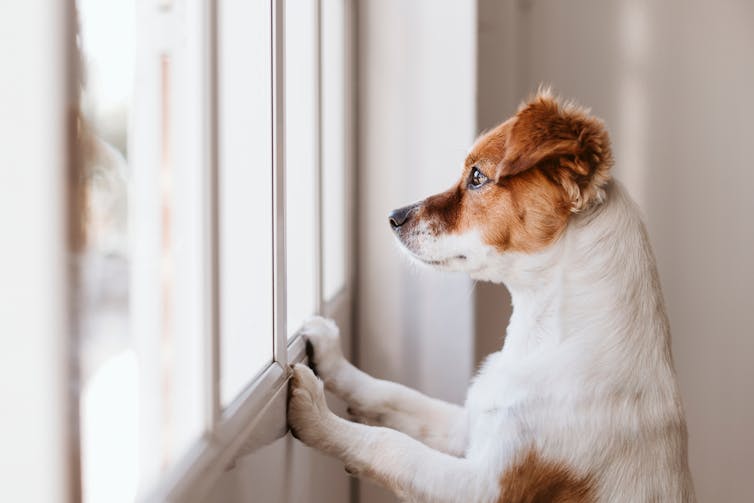
And considering the biggest killer of dogs under three years old is behavioural euthanasia, it’s important to take steps to enrich your dog’s environment.
But first, let’s discuss our own behaviour around dogs.
Keep good hygiene around pets
COVID-19 spreads from human to human and, to date, there is no evidence that companion animals spread the disease.
Read more: Hong Kong dog causes panic – but here’s why you needn’t worry about pets spreading COVID-19
That said, it’s best to touch only your own dog over the next few months and not allow others to cuddle your puppy or dog. The World Organisation of Animal Health says:
When handling and caring for animals, basic hygiene measures should always be implemented. This includes hand washing before and after being around or handling animals, their food, or supplies, as well as avoiding kissing, licking or sharing food.
When possible, people who are sick or under medical attention for COVID-19 should avoid close contact with their pets and have another member of their household care for their animals. If they must look after their pet, they should maintain good hygiene practices and wear a face mask if possible.
Social isolation for social animals
If you’re suddenly working from home a lot or in lockdown, your dog is probably over the moon.
Dogs thrive on contact with members of their social group. So, it might be hard to get work done with your dog vying for your attention.
Encourage your dog to settle with items to lick and chew, such as pigs’ ears and food-dispensing toys, but avoid giving these items in response to being pestered. Break up the day with smaller, more frequent meals and regular toilet breaks.
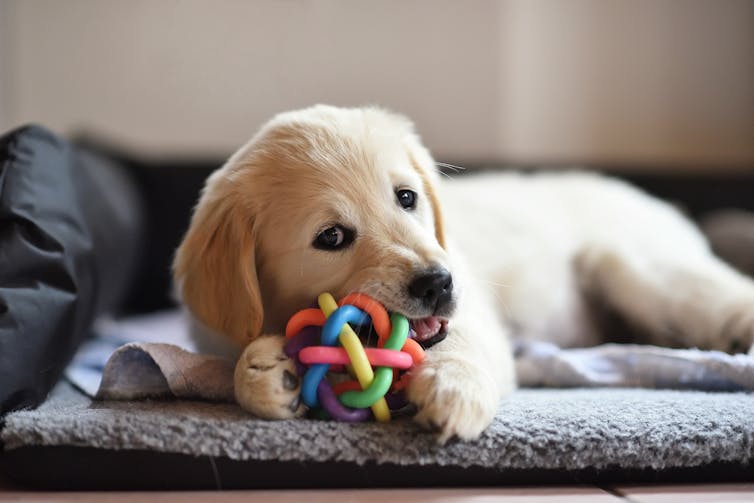
Many dogs are accustomed to receiving daily exercise and having much of their social needs met through play with other dogs in public areas. If this is no longer an option, you may find your dog is unusually active and mischievous at home.
Now may be the time to create structure such as “play” and “quiet time” cues so your pets don’t learn to demand your attention at any time.
Puppy socialisation
Puppies’ social needs are the greatest of all. It’s critical for vaccinated puppies to be socialised with lots of different people, dogs and environments. But under social isolation, finding opportunities for these encounters may be difficult.
Read more: Why dogs don’t care for being groomed (and for the love of dog don’t snip their whiskers)
It’s safe for dogs to play with other dogs. So, if you go for a walk with your dogs, and they see another dog, they can be allowed to greet each other, but their contact with other humans should not be encouraged. The same principle applies to dog parks and play dates.
For puppies, looking at objects is the next best thing to touching them, and they can learn about their environment through short excursions to see traffic, pedestrians and other dogs.
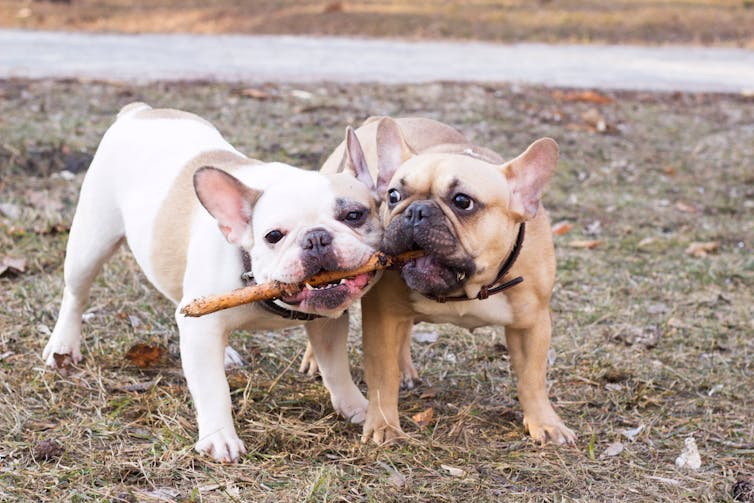
From within a vehicle, puppies can observe traffic and other animals. And from the safety of their own home, they can and should be gradually exposed to various recorded sounds, such as thunder, babies crying and vacuum cleaners.
Play learning games
With the shutdown of social gatherings, pups will inevitably miss out on important socialisation opportunities. This may create the need for extra training when life returns to normal.
But while dog-training businesses may be reducing their services, many are offering online courses and training challenges through social media to help people stay engaged and on top of their dog’s training.
Read more: 8 things we do that really confuse our dogs
Canine challenges includes scent games (often called nosework), which are great enrichment for dogs.
Dogs are experts at sniffing out objects, and practising these skills with toys in the yard or on the balcony gives them an outlet for these natural abilities (and it can be lots of fun for the humans too).
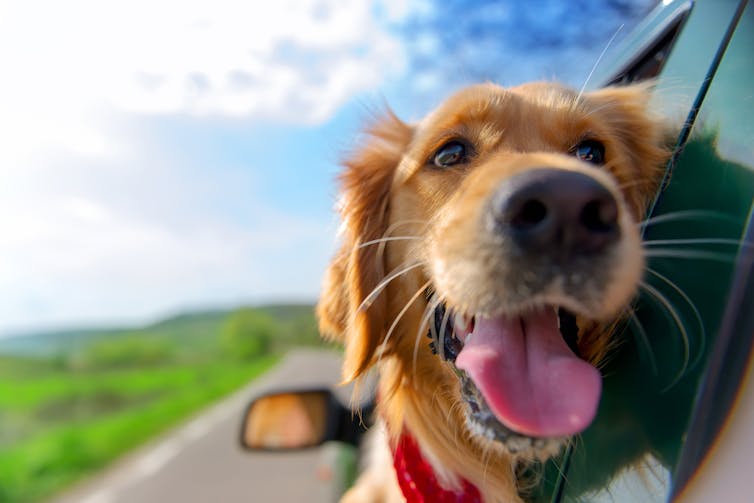
You’d be amazed how good they are at tracking your scent, even indoors. With the right food or toy rewards, playing hide and seek with your dog is also an opportunity to reinforce an excellent recall.
What happens if we stop working from home?
Dogs like to be with their social group at all times, and they may come to expect they’ll always be involved.
Recent research into separation-related distress (SRD) suggests this is a very complicated phenomenon with multiple possible causes. Hyper-attachment to owners and panic when left alone aren’t the only reason dogs can develop SRD. Frustration, noise sensitivity and other anxieties may also exacerbate SRD.
For puppies growing up in the COVID-19 era of free access to human owners, it’s particularly important for them to learn that separation from their owners is normal and non-threatening.
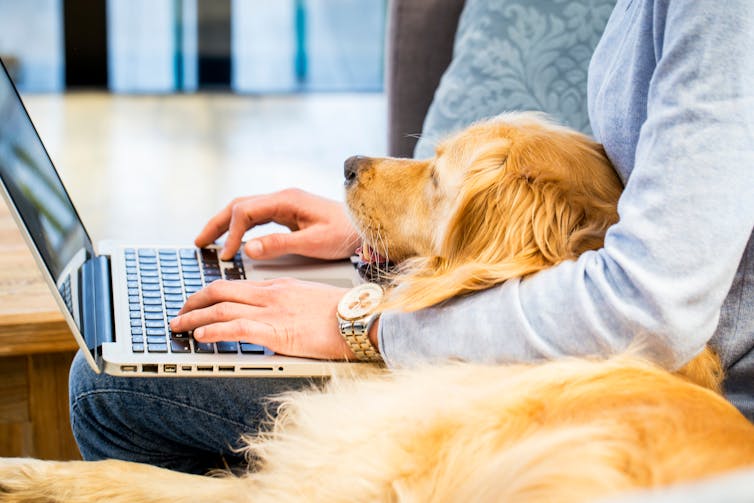
If you’ve got a new puppy or an at-risk dog such as those with a history of anxiety, make an effort to separate them for short periods. This may be another good reason to create a work routine while working from home: time for exercise, time for food, time for games and time to work without interruptions.
Stay active and engaged
Our canine friends may give us reasons to stay physically active while many of our usual activities have been cancelled, and they may provide comfort to us in this time of social isolation.
By keeping up with environmental enrichment, you can make sure your four-legged best friend doesn’t suffer from cabin fever. If you have a puppy or are bringing home a new dog, plan how to set them up for life post-COVID-19.
Read more: Is it ethical to keep pets and other animals? It depends on where you keep them
Melissa Starling, Postdoctoral researcher, University of Sydney; Jacqueline Norris, Professor of Veterinary Microbiology and Infectious Diseases, Sydney School of Veterinary Science, University of Sydney, and Paul McGreevy, Professor of Animal Behaviour and Animal Welfare Science, University of Sydney
This article is republished from The Conversation under a Creative Commons license. Read the original article.
953 total views, 0 today
COVID-19 / Coronavirus and Pets – facts to date
Hong Kong dog causes panic – but here’s why you needn’t worry about pets spreading COVID-19

Sarah L Caddy, University of Cambridge
A Pomeranian dog in Hong Kong grabbed the international media’s attention this week after scientists found traces of coronavirus in the canine. Following confirmation that the dog’s owner was positive for the virus causing COVID-19, the dog was taken from Hong Kong Island to a nearby animal quarantine facility. Subsequent tests performed on swabs collected from the dog’s nose and throat unexpectedly revealed coronavirus.
These results have raised many questions and concerns. Can our dogs really catch the virus? Should we be worried about our pets getting sick? Could dogs spread coronavirus between people?
A positive test for coronavirus in this dog simply means that a small piece of viral genome was detected in a sample. PCR (a test used to detect genetic material) is a highly sensitive method of testing but is unable to tell whether coronavirus was replicating in the dog or whether the dog had simply licked contaminated surfaces in the home.
Read more: Coronavirus: a weekly update from The Conversation’s global network of academics
It is unknown exactly how long the virus causing COVID-19 disease, called SARS-CoV-2, can survive in the environment. A study of other coronaviruses suggests they can remain infectious for several days if the temperature and humidity are right. Given that we don’t even know if the virus detected was infectious or not, we have no idea whether virus replication occurred in this particular dog.
We know that SARS-CoV-2 is transmitted by droplets, so it’s possible that dogs could act as dirty tissues, or “fomites”, that walk the virus around if adequate hygiene is not maintained.

Whereas SARS-CoV-2 has the limelight at present, there are actually many different types of coronaviruses, and coronaviruses infecting dogs is nothing new. The first coronavirus to be reported in dogs was back in 1974. More recently in 2003, a novel canine coronavirus causing respiratory disease was identified in dogs in an animal shelter in the UK. This virus has since been reported worldwide.
Although canine coronaviruses are distinct from SARS-CoV-2, dogs are clearly susceptible to this family of viruses. Despite this, there are no previous instances of human coronaviruses infecting dogs or vice versa. For a virus to jump species, there are several hurdles they must overcome.
The major barrier that stops a virus infecting a new type of animal is the host-cell surface. To infect canine cells, SARS-CoV-2 must be able to bind (attach) to canine receptors. Thanks to rapid research, we now know that SARS-CoV-2 uses the proteins ACE2 and TMPRSS2 to gain entry into cells. Dogs have both these proteins, but they are not identical to the human versions, so the virus may not be able to use them as efficiently.
If we assume that the virus can bind, enter and replicate within canine cells (this is still a big if), then it is reasonable for dog owners to be worried about whether their dogs will become sick following infection. It is reassuring that the Pomeranian at the centre of this media attention has not shown any signs of illness. Though this is a single case study, there is no reason to believe that the human virus should cause disease in dogs at this stage.
Could dogs transmit SARS-CoV-2 to humans?
To pass on coronavirus, the virus must replicate in dogs at high enough levels to be released from the body. Reports state that only low levels of the virus could be detected in the Pomeranian. How much virus does it take to infect a person? Again, we don’t yet know.
We do know for a number of different viruses that, although human-to-dog transmission is theoretically possible, human-to-human spread is much more efficient. We and others have shown that dogs can be susceptible to human norovirus, a major cause of vomiting and diarrhoea worldwide. Yet despite millions of cases of this virus each year, only a single definitive instance of human-to-dog transmission has been reported. Full genome sequencing was instrumental in that particular case, and will also be required to conclusively prove a role for dogs in the current SARS-CoV-2 outbreak.
Even in the worst-case scenario of coronavirus being able to replicate in dogs at reasonable levels, it is safe to assume that you are much more likely to be infected by your neighbour than your dog. However, it is essential to practice good hygiene around any pets. This will prevent them from inadvertently carrying viruses on their coats and spreading it from person to person. Please cough into your elbow, not on to your dog.
Sarah L Caddy, Clinical Research Fellow in Viral Immunology and Veterinary Surgeon, University of Cambridge
This article is republished from The Conversation under a Creative Commons license. Read the original article.
883 total views, 1 today
Pets are Family – making a difference in peoples’ lives
When pets are family, the benefits extend into society

L.F. Carver, Queen’s University, Ontario
There is a growing global trend to consider pets as part of the family. In fact, millions of people around the world love their pets, enjoying their companionship, going for walks, playing and even talking to them. And there is evidence suggesting that attachment to pets is good for human health and even helps build community.
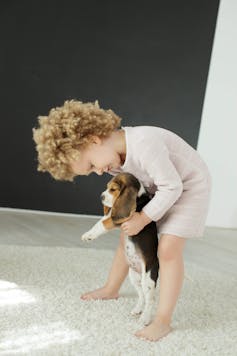
More and more often, animals are included in family events and become important to all members of the family. This can be particularly significant in single-parent families, where a pet can be an important companion to children. Children with pets may have higher levels of empathy and self-esteem compared to those who do not have pets. Thinking of pets as family members can actually make the chores associated with pet care less stressful than they are for those who consider pets as property. Spending more time caring for a pet increases attachment to that animal which in turn reduces stress in owners.
In the research my colleagues and I have done on aging and social participation, we found considerable analysis showing that interactions involving pets, especially if we care about them, can have a health-protective effect. Zooeyia (pronounced zoo-AY-uh) is the idea that pets, also known as companion animals, can be good for human health. In fact, pet owners in Germany and Australia were found to visit their doctor 15 per cent fewer times annually than non-pet owners.
Healthy, emotional connections
Many health benefits to humans occur when there is an emotional attachment to pets. And we tend to care the most for animals that live with us. For example, a study that looked at attachment to dogs found that people tended to care about their house dogs more than those that lived in the yard. Higher levels of attachment to dogs has been associated with a greater likelihood of walking the dog and spending more time on those walks as compared with those with a weaker bond to their dogs.
Sharing your life with a pet has been associated with a decreased risk of coronary artery disease, a reduction in stress levels and increased physical activity (especially through dog walking). The presence of a pet during stressful activities has been shown to lower the blood pressure of couples taking part in a stressful task. In fact, levels of beta-endorphin, oxytocin and dopamine, among other markers, increased in both humans and their dogs during caring interactions, demonstrating that time spent together is physiologically beneficial for both species. And owning a pet has been associated with an improved cardiovascular disease survival among older adults (aged 65 to 84 years old) being treated for hypertension.
Pets as family and community members
Because pets are considered family members by many people, the loss of a dog or cat is often a cause for deep grief. A missing or dead pet is hard for many to replace because the relationship between the person and pet was specific to those individuals. The attachment between humans and animals is often so strong that it is common to mourn in a way that is very similar to the feelings and behaviours associated with the loss of a human family member.
The bond between humans and animals is not just good for human health, it can also help build community. People with pets often find that activities with their companion animal creates connections with other people. Social networks that are developed based on shared concern over the welfare of animals can lead to increased human-human interaction, as well as activities involving pets (e.g. dog-walking clubs). Walking a dog gets people out of private spaces, which can be isolating, and into public areas where interactions with neighbors and other walkers are possible.

Protecting pets
Societies create laws and institutions to protect companion animals from cruelty and neglect. In most jurisdictions, regulation of shelters and pounds has not evolved to reflect the beloved status of many pets, and instead consider pets as property. If a lost pet is not reunited with an owner within a few days it can be sold to a new family, to a research lab, or be euthanized. However, some countries, such as India, Italy and Taiwan have legislated against the euthanasia of healthy shelter animals.
But in North America euthanasia is still common. In 2017, Humane Canada found that among the shelters they surveyed, over 70 per cent of lost dogs and cats were unclaimed, and tens of thousands of dogs and cats were euthanized. In 2016, 4,308,921 animals were experimented on in Canadian laboratories. Approximately 17,000 were pet dogs and cats who were provided by shelters to research laboratories and later euthanized.
The strength of the human-animal bond has resulted in the creation of not-for-profit animal rescues whose mission is to ‘pull’ lost and abandoned animals from shelters before they are euthanized or sold for research. For example, Marley’s Hope is a Nova Scotia all-breed rescue organization. The organisation also partners with the Sipekne’katik First Nation to help rehome roaming dogs as well as spay and neuter where possible. The Underdog Railroad in Toronto, Ontario, rescues dogs and cats from high-kill shelters as well as those offered “free to a good home” online. And Elderdog provides older adults with help to care for their pets as well as rescuing abandoned older dogs.
The Humane Society International — Canada assists in spay-neuter programs as well as advocating for and rescuing animals, including in the international dog and cat meat industries. They closed three South Korean dog meat farms and two slaughterhouses in 2018, rescuing 512 dogs, many of whom found homes in Canada and the USA.
Mohandas Ghandi understood the importance of the human animal bond. In his autobiography he said “man’s supremacy over the lower animals meant not that the former should prey upon the latter, but that the higher should protect the lower, and that there should be mutual aid between the two.” Recognizing the ways that companion animals enrich human lives, and understanding the depth of the affection between many humans and animals, may be the key to not only better health, but to improving the welfare of society as a whole.
L.F. Carver, Post Doctoral Fellow, Queen’s University and Ageing + Communication + Technologies (ACT) (SSHRC funded), Queen’s University, Ontario
This article is republished from The Conversation under a Creative Commons license. Read the original article.
752 total views, 1 today
Public support for Animal Rights in the USA goes beyond keeping Dogs out of overhead bins
Author: Garrett M. Broad
Assistant Professor, Fordham University
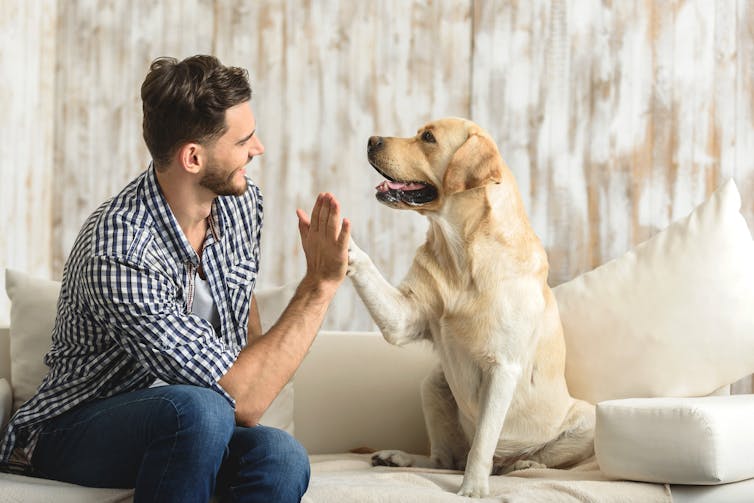
Olena Yakobchuk/Shutterstock.com
Garrett M. Broad, Fordham University
A French bulldog named Kokito recently died aboard a United Airlines plane after a flight attendant ordered his owner to place him in an overhead bin.
Public outrage ensued. Proposed bipartisan legislation, now pending in the Senate, would make airlines pay fines for such incidents. Democrat Marisol Alcantara, a New York state lawmaker representing Manhattan, even drafted a bill of rights for animal passengers.
As a researcher interested in how society treats animals, I recently worked with an animal advocacy nonprofit to conduct a nationally representative survey that investigated what the public thinks about animals and their rights. The results showed that a clear majority of people identify as animal lovers. But not every self-professed animal lover supports full legal rights for animals.
For me, Kokito’s tragic death illustrates a broader controversial legal question, not just in the air but on the ground. Whose rights were actually violated in that overhead bin? The human passenger’s – or the dog’s?
Animals as property
U.S. law treats humans as the only animals considered “legal persons” capable of having rights. It designates all wild and domesticated animals, by contrast, as “legal things.” Pets and farmed animals alike are a form of property – by definition, they have no rights of their own.
There has been considerable legal and philosophical debate on this topic. Some legal scholars see no reason to change the status quo, arguing that animals are best protected through welfare regulations and anti-cruelty statutes that focus on how people treat them. A number of other activists and scholars, such as Harvard University’s Cass Sunstein, insist that it’s time to break down the legal barrier that separates humans from animals, calling for a limited set of animal rights that must be respected by the law.
To be sure, animals would never be able to vote or run for public office with this new status. But they would obtain the individual rights that would protect them from many forms of abuse and confinement, and people would be able to file lawsuits on their behalf.
To gauge public sentiment on this question, I worked with Qualtrics, a market research and survey company, to poll 1,044 Americans. These people were nationally representative in terms of their age, race and ethnicity, gender, income and region. The survey had a 3 percent margin of error.
About nine in 10 Americans, according to my survey, support some form of legal rights for animals. Nearly half believe that animals deserve the exact same rights as people. Only about 5.5 percent said they thought animals need little to no legal protection at all.
This survey is only the latest indication that support for the rights of animals is strong.
A 2015 Gallup poll, for instance, found that about one in three Americans believed animals should be given the same rights as people, up from one in four in 2008. Both times, Gallup found that only 3 percent supported largely denying animals any rights at all.
Legal personhood
The Nonhuman Rights Project, a nonprofit aiming to secure legal personhood rights for animals, commissioned me to conduct the survey.
The group’s legal efforts, however, haven’t focused on dogs like Kokito. Instead, it has advocated on behalf of animals like Tommy and Kiko, two 30-something male chimpanzees who spent most of their lives as film performers and in roadside zoo cages.
The Nonhuman Rights Project argues that great apes should be the first animals transformed from “legal things” into “legal persons.” They point to chimpanzees’ scientifically demonstrated autonomy and their high level of emotional and cognitive complexity as the basis for this argument.
The nonprofit also insists that legal personhood isn’t limited to humans under U.S. law. The state technically treats corporations as rights-bearing persons. Several other nations, including New Zealand, India and Ecuador, recognize the legal personhood of rivers.
Although noted philosophers and law scholars support the notion of animal personhood, it has consistently lost in court. Many legal thinkers have dismissed the nonprofit’s lawsuits as frivolous and out of step with public morals and longstanding human intuition.
To clarify what the public actually thinks of granting these types of legal rights to chimpanzees and other autonomous animals, one survey question provided this background information:
“Some people believe that new laws should be passed that give certain species of highly intelligent animals – including great apes, elephants, and cetaceans like whales and dolphins – the legal right of bodily liberty, which would guarantee them freedom from imprisonment. Supporters of these laws want to remove animals from places like zoos, circuses, and research facilities and relocate them to sanctuaries and other protected nature reserves instead.”
Then, respondents were asked how inclined they would be to vote in favor of such a law or vote for a politician who supported it.
About half of the people taking part in my survey said they agreed with the Nonhuman Rights Project’s goals, while only one in five opposed them. Women and Democrats were the most likely to strongly favor these ideas. Few other clear patterns regarding differences of opinion emerged based on ethnic background, region, education level, income or religion.
A complicated relationship
In my view, the way modern society treats animals remains full of contradictions. While millions of household pets like Kokito are treated as members of the family, countless other animals suffer in places like factory farms.
Around 7.5 billion land animals are slaughtered annually in the U.S. for food. On average, a typical American consumes some 60 pounds of chicken, 50 pounds of beef and 15 pounds of seafood per year. My survey found that only about 6 percent of respondents followed a vegetarian or vegan diet, which is in line with other research on that question.
Despite the dominant culinary habits of Americans, public opinion polling and the uproar following Kokito’s untimely death aboard a United Airlines flight both point to how people want to see a world that grants animals significant legal protections. Many Americans even appear open to the idea of granting legal personhood to certain animals.
![]() It remains to be seen, however, whether the rights of animals will ever become guaranteed by U.S. law.
It remains to be seen, however, whether the rights of animals will ever become guaranteed by U.S. law.
Garrett M. Broad, Assistant Professor of Communication and Media Studies, Fordham University
This article was originally published on The Conversation. Read the original article.
841 total views, 1 today